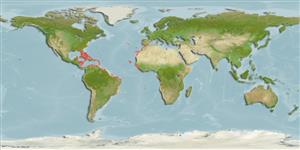Classification / Names
Common names from other countries
Main reference
Size / Weight / Age
Max length : 22.9 cm TL male/unsexed; (Ref. 26340); common length : 15.0 cm SL male/unsexed; (Ref. 3139); max. published weight: 200.00 g (Ref. 5288)
Length at first maturity
Lm 15.0, range 10 - ? cm
Environment
Marine; reef-associated; non-migratory; depth range 0 - 20 m (Ref. 58047), usually ? - 10 m (Ref. 86997)
Climate / Range
Subtropical, preferred ?; 41°N - 37°S, 89°W - 14°E
Distribution
Atlantic Ocean: Canada (Ref. 5951) to Rhode Island, USA to Uruguay in the western Atlantic, abundant on Caribbean reefs; around islands of the mid-Atlantic, Cape Verde, and along the tropical coast of western Africa south to Angola. This species is strictly an Atlantic species. It is replaced in the Indo-Pacific region by the closely related Abudefduf vaigiensis (G. Allen, pers. comm.).
Countries | FAO areas | Ecosystems | Occurrences | Introductions
Short description
Dorsal
spines
(total): 13;
Dorsal
soft rays
(total): 12-13;
Anal
spines: 2;
Anal
soft rays: 10 - 12. Greenish yellow above, shading to white below, with 5 prominent vertical black bars that narrow toward belly (Ref. 26938). A faint sixth bar may be present posteriorly on caudal peduncle; a black spot at upper base of pectoral fin. The adult male becomes dark bluish, the black bars thus less conspicuous on the body (Ref. 13442).
IUCN Red List Status (Ref. 115185)
Threat to humans
Harmless
Human uses
Fisheries: minor commercial; aquarium: commercial
More information
ReferencesAquacultureAquaculture profileStrainsGeneticsAllele frequenciesHeritabilityDiseasesProcessingMass conversion
Tools
Special reports
Download XML
Internet sources
Estimates of some properties based on models
Phylogenetic diversity index
PD50 = 0.5000 many relatives (e.g. carps) 0.5 - 2.0 few relatives (e.g. lungfishes)
Trophic Level
3.8 ±0.2 se; Based on diet studies.
Resilience
Medium, minimum population doubling time 1.4 - 4.4 years (Preliminary K or Fecundity.)
Vulnerability
Low to moderate vulnerability (32 of 100)
Price category
